When most people think of the month of May, in their mind’s eye, they see: spring-time, renewal, rebirth, flowers, sunshine, laughter of children playing outside. I, on the other hand, see the beginning of an end. The beginning of unimaginable hell. Most specifically, I see a teenage Bosniak girl being raped by Serb paramilitary units. Her parents restrained behind a fence while she’s being raped repeatedly. After a while she’s left alone in a pool of her own blood …
My birth-town, Prijedor, Bosnia in 1992.
The other day, a ninety year old man, said to me: “You can’t possibly understand what those poor people in Ukraine are going through!”
“I’m Bosnian.” I replied quietly. Not giving him any more information than that, knowing full-well he knew about the war in Bosnia. He lived through the early 1990’s and was hearing about the horrible war in Europe on the news then, just like we’re hearing about Ukraine now. He didn’t say anything else to me about the subject. His confrontational demeanor changed instantly while the look on his face became a little softer as he understood why I was reluctant to carry on the conversation about the Ukraine in the first place, which he obviously craved so much in hopes of teaching this “ignorant, spoiled, young American girl” about the “real” struggles of the world. He assumed I was younger than I am, therefore, he assumed, I was spoiled and didn’t know anything.
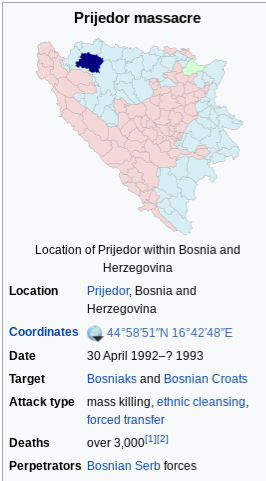
en.wikipedia.org
I let it go. He wasn’t worth my time nor energy. He did, however, bring up the memories I just can’t escape no matter how hard I try.
I was born in Prijedor and in 1992, I was only 15.
You see, when other people talk about the war, what they think is happening is army against another army, buildings being blown-up, dead bodies on the street and screaming children … for those are the images that are constantly being displayed on our TV sets. But what I see–in my mind’s eye– behind those news-images is a little different and a lot darker. What I see and know first hand is truly happening is a young girl being raped repeatedly by men in uniform, while her parents are restrained behind the fence.
Let me tell you about her: she is scrawny. Tall, but skinny. Shy beyond comprehension. She only speaks when spoken to. Always quiet. She is beautiful, although, she doesn’t know it yet and she wouldn’t believe you if you told her so. She loves her school-mates and her teachers. She loves her parents and grandparents, her aunts and uncles and even though she has no siblings, she thinks of her cousins as her brothers and sisters. Most of all, she loves books. She reads about distant places and people she would love to visit and meet some day. She’s a day-dreamer. She is happy. She is your typical little girl. She could be your daughter or your sister. Maybe a cousin or even a girl you’re crushing on. She could be you.
She doesn’t know anything about politics and quite frankly, she doesn’t care about such adult matters. She thinks she’s in love with her childhood crush.
In 1992 her whole world crumbles. Her loved ones are being tortured and killed. Thrown away into concentration camps. She doesn’t know why. She’s being punished, but she can’t understand nor remember what it was that she did that was so horrible to be punished so severely …
Following Slovenia’s and Croatia’s declarations of independence in June 1991, the situation in the Prijedor municipality rapidly deteriorated. During the war in Croatia, the tension increased between the Serbs and the communities of Bosniaks and Croats.
During the night of 29/30 April 1992, the takeover of power took place. The ICTY concluded that the takeover by the Serb politicians was an illegal coup d’état, which was planned and coordinated a long time in advance with the ultimate aim of creating a pure Serbian municipality.
During the Bosnian War, there was an ethnic cleansing campaign committed by the Bosnian Serb political and military leadership – Army of the Republika Srpska, against Bosniak and Croat civilians in the Prijedor region of Bosnia and Herzegovina in 1992 and 1993. The composition of non-Serbs was drastically reduced: out of a population of 50,000 Bosniaks only some 6,000 Bosniaks remained in the municipality by the end of the war. Prijedor is the area with the second highest rate of civilian killings committed during the Bosnian War.
As of October 2013, 96 mass graves have been located and around 2,100 victims have been identified, largely by DNA analysis.
Concentration Camps:
Keraterm Camp was set up as a camp on or around 23/24 May 1992.
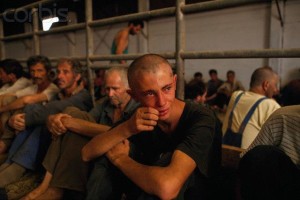 Omarska Camp: The Omarska mines complex was located about 20 km from the town of Prijedor. The first detainees were taken to the camp sometime in late May 1992 (between 26 and 30 May). The camp buildings were almost completely full and some of the detainees had to be held on the area between the two main buildings. That area was lit up by specially installed spot-lights after the detainees arrived. Female detainees were held separately in the administrative building. According to the Serb authorities documents from Prijedor, there were a total of 3,334 persons held in the camp from 27 May to 16 August 1992. 3,197 of them were Bosniaks (i.e. Bosnian Muslims), 125 were Croats.
Omarska Camp: The Omarska mines complex was located about 20 km from the town of Prijedor. The first detainees were taken to the camp sometime in late May 1992 (between 26 and 30 May). The camp buildings were almost completely full and some of the detainees had to be held on the area between the two main buildings. That area was lit up by specially installed spot-lights after the detainees arrived. Female detainees were held separately in the administrative building. According to the Serb authorities documents from Prijedor, there were a total of 3,334 persons held in the camp from 27 May to 16 August 1992. 3,197 of them were Bosniaks (i.e. Bosnian Muslims), 125 were Croats.
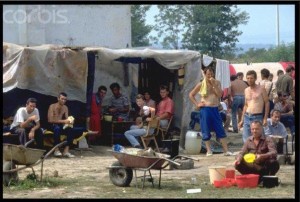 With the arrival of the first detainees, permanent guard posts were established around the camp, and anti-personnel landmines were set up around the camp. The conditions in the camp were horrible. In the building known as the “White House”, the rooms were crowded with 45 people in a room no larger than 20 square meters. The faces of the detainees were distorted and bloodstained and the walls were covered with blood. From the beginning, the detainees were beaten, with fists, rifle butts and wooden and metal sticks. The guards mostly hit the heart and kidneys, when they had decided to beat someone to death. In the “garage”, between 150 and 160 people were “packed like sardines” and the heat was unbearable.
With the arrival of the first detainees, permanent guard posts were established around the camp, and anti-personnel landmines were set up around the camp. The conditions in the camp were horrible. In the building known as the “White House”, the rooms were crowded with 45 people in a room no larger than 20 square meters. The faces of the detainees were distorted and bloodstained and the walls were covered with blood. From the beginning, the detainees were beaten, with fists, rifle butts and wooden and metal sticks. The guards mostly hit the heart and kidneys, when they had decided to beat someone to death. In the “garage”, between 150 and 160 people were “packed like sardines” and the heat was unbearable.
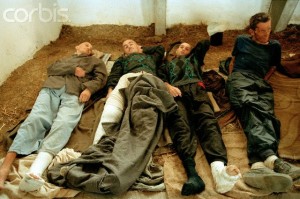 For the first few days, the detainees were not allowed out and were given only a jerry can of water and some bread. Men would suffocate during the night and their bodies would be taken out the following morning. The room behind the restaurant was known as “Mujo’s Room”. The dimensions of this room were about 12 by 15 metres and the average number of people detained there was 500, most of whom were Bosniaks. The women in the camp slept in the interrogations rooms, which they would have to clean each day as the rooms were covered in blood and pieces of skin and hair. In the camp one could hear the moaning and wailing of people who were being beaten up.
For the first few days, the detainees were not allowed out and were given only a jerry can of water and some bread. Men would suffocate during the night and their bodies would be taken out the following morning. The room behind the restaurant was known as “Mujo’s Room”. The dimensions of this room were about 12 by 15 metres and the average number of people detained there was 500, most of whom were Bosniaks. The women in the camp slept in the interrogations rooms, which they would have to clean each day as the rooms were covered in blood and pieces of skin and hair. In the camp one could hear the moaning and wailing of people who were being beaten up.
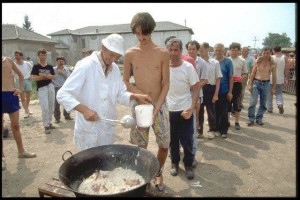 The detainees at Omarska had one meal a day. The food was usually spoiled and the process of getting the food, eating and returning the plate usually lasted around three minutes. Meals were often accompanied by beatings. The toilets were blocked and there was human waste everywhere. Ed Vulliamy, a British journalist, testified that when he visited the camp, the detainees were in a very poor physical condition. He witnessed them eating a bowl of soup and some bread and said that he had the impression they had not eaten in a long time. They appeared to be terrified. The detainees drank water from a river that was polluted with industrial waste and many suffered from constipation or dysentery. No criminal report was ever filed against persons detained in the Omarska camp, nor were the detainees apprised of any concrete charges against them. Apparently, there was no objective reason justifying these people’s detention. The Omarska camp was closed immediately after a visit by foreign journalists in early August.On 6 or 7 August 1992, the detainees at Omarska were divided into groups and transported in buses to different destinations. About 1,500 people were transported on 20 buses.
The detainees at Omarska had one meal a day. The food was usually spoiled and the process of getting the food, eating and returning the plate usually lasted around three minutes. Meals were often accompanied by beatings. The toilets were blocked and there was human waste everywhere. Ed Vulliamy, a British journalist, testified that when he visited the camp, the detainees were in a very poor physical condition. He witnessed them eating a bowl of soup and some bread and said that he had the impression they had not eaten in a long time. They appeared to be terrified. The detainees drank water from a river that was polluted with industrial waste and many suffered from constipation or dysentery. No criminal report was ever filed against persons detained in the Omarska camp, nor were the detainees apprised of any concrete charges against them. Apparently, there was no objective reason justifying these people’s detention. The Omarska camp was closed immediately after a visit by foreign journalists in early August.On 6 or 7 August 1992, the detainees at Omarska were divided into groups and transported in buses to different destinations. About 1,500 people were transported on 20 buses.
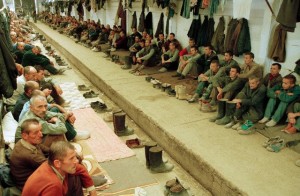 Trnopolje Camp was set up in the village of Trnoplje on 24 May 1992. The camp was guarded on all sides by the Serb army. There were machine-gun nests and well-armed posts pointing their guns towards the camp. There were several thousand people detained in the camp, the vast majority of whom were Bosnian Muslim and some of them were Croats. According to approximation, on 7 August 1992 there were around 5,000 people detained there. Women and children were detained at the camp as well as men of military age. The camp population had a high turnover with many people staying for less than a week in the camp before joining one of the many convoys to another destination or concentration camps. The quantity of food available was insufficient and people often went hungry. Moreover, the water supply was insufficient and the toilet facilities inadequate. The majority of the detainees slept in the open air. The Serb soldiers used baseball bats, iron bars, rifle butts and their hands and feet or whatever they had at their disposal to beat the detainees. Individuals were who taken out for questioning would often return bruised or injured. Many women who were detained at the Trnopolje camp were taken out of the camp at night by Serb soldiers and raped or sexually assaulted.
Trnopolje Camp was set up in the village of Trnoplje on 24 May 1992. The camp was guarded on all sides by the Serb army. There were machine-gun nests and well-armed posts pointing their guns towards the camp. There were several thousand people detained in the camp, the vast majority of whom were Bosnian Muslim and some of them were Croats. According to approximation, on 7 August 1992 there were around 5,000 people detained there. Women and children were detained at the camp as well as men of military age. The camp population had a high turnover with many people staying for less than a week in the camp before joining one of the many convoys to another destination or concentration camps. The quantity of food available was insufficient and people often went hungry. Moreover, the water supply was insufficient and the toilet facilities inadequate. The majority of the detainees slept in the open air. The Serb soldiers used baseball bats, iron bars, rifle butts and their hands and feet or whatever they had at their disposal to beat the detainees. Individuals were who taken out for questioning would often return bruised or injured. Many women who were detained at the Trnopolje camp were taken out of the camp at night by Serb soldiers and raped or sexually assaulted.
Other detention facilities:
There were also other facilities in Prijedor which were used to detain Bosniak and other non-Serb people. Such detention facilities included Yugoslav People’s Army barracks, Miška Glava Community Centre and a police building in Prijedor known as the SUP building.
Numerous killings, both inside and outside the camps were committed during the Prijedor ethnic cleansing.
This is the true face of a war. These are the images I see when someone tries to “educate” me on the horrors of the war …
The reason I’m bringing it up … honestly, I don’t know what the reason is. It’s not like you as an individual can change the world and stop all wars. I guess, what I’m trying to say is, try to be a little nicer to people you meet who speak with an accent. You have no idea what horrors they just left behind. You couldn’t possibly understand the anguish that’s going through them now. They don’t want anything from you, but to feel safe and accepted. Their healing period is just beginning and believe me when I say, contrary to a popular belief, time does NOT heal all wounds.
Be kind. Always.
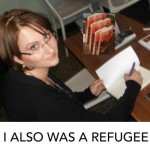 “I truly believe that I survived for one reason and one reason only: to tell our story, to give a voice to those who don’t have it anymore. I was there as a witness. As a survivor, I have an obligation. I have to talk about what had happened in Bosnia back in 1992, no matter the cost!” ~Sanela Ramic Jurich
“I truly believe that I survived for one reason and one reason only: to tell our story, to give a voice to those who don’t have it anymore. I was there as a witness. As a survivor, I have an obligation. I have to talk about what had happened in Bosnia back in 1992, no matter the cost!” ~Sanela Ramic Jurich
